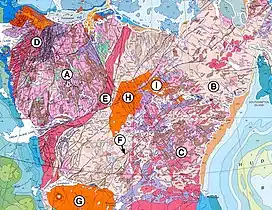Wopmay orogen
The Wopmay orogen is a Paleoproterozoic orogenic belt in northern Canada which formed during the collision between the Hottah terrane (north of the Hottah Lake), a continental magmatic arc, and the Archean Slave Craton at about 1.88 Ga (billion years). The collision lead to the short-lived Calderian orogeny.[1] The formation was named for Wilfrid Reid "Wop" May, OBE, DFC (April 20, 1896 – June 21, 1952), a Canadian flying ace in the First World War and a leading post-war aviator.

It is approximately 500 km along the north–south axis, and 200 km along the east–west axis at its widest point, tapering at both the northern and southern ends.[2]
Geological setting
The Wopmay orogen can be subdivided into (east to west): a passive continental margin, the Wopmay fault zone, the Great Bear magmatic zone, and the Hottah terrane. The passive margin developed around 1970–1890 Ma on-top of the Slave Craton. The Wopmay fault zone is probably a suture between the Slave craton and the Hottah terrane. No Archean crust have been found west of this suture. The Great Bear magmatic zone is the result of arc magmatism around 1875–1840 Ma when these rocks were deposited on and intruded into the Hottah terrane and Slave craton. The magmatic arc now forms a 3–4.5 km thick basin overlying the Hottah-Slave transition. The cryptic Hottah terrane is a magmatic arc which consists of a 1936–1890 Ma-old suite of plutons intruded into 2.0–2.4 Ga metamorphosed sedimentary and volcanic rocks. It probably extends east beneath the Great Bear magmatic zone.[3]
Tectonic evolution
The Wopmay orogen formed 1882±4 Ma when the Coronation paleocean (named after the Arctic Coronation Gulf) closed between the western margin of the Slave craton and Hottah terrane. The Great Bear magmatic arc remained active 1.88–1.84 Ma while subduction still occurred and still bisects the Hottah terrane north to south. The Coronation margin final closure occurred at 1.74 Ga. The date for the opening of the Coronation Ocean is uncertain, but isotopic studies indicate that initial rifting must be older than about 1.97 Ga.[4] The Hottah arc formed 2.4–2.0 Ga on cryptic crust, probably coeval with sedimentation of Coronation margin. The closure of Coronation Ocean saw an initial phase of westward-directed subduction of oceanic crust beneath the Hottah terrane. This process was followed by an interrupted eastward subduction around 1.885 Ga during which the Coronation margin and Hottah terrane were translated eastward and partially thrust over the Slave craton.[5]
Significance
Sites such as the Wopmay Orogen provide evidence for early and ongoing plate tectonics. Traces of old oceanic crust, island arcs, and colliding continents indicate that the same forces at work today have been at work in the early Proterozoic and probably earlier. Alignments of magnetic particles in rocks demonstrate that continents were drifting across the surface of the Earth relative to the magnetic poles then as now, and that the ocean floor was rifting and subducting, all at least 1.5 billion years ago.[6][7] This crust cycling is referred to as the supercontinent cycle.[7]
References
Notes
- Hildebrand, Hoffman & Bowring 2010, Abstract
- "Comparisons of the 2005 Geologic Map of North America with the 1965 Map, Areas 1-4; Area 2, Northwestern Canadian Shield". Geology and Environmental Change Science Center. United States Geological Survey (USGS). Retrieved 22 May 2016.
- Spratt et al. 2009, Geology and Tectonics, pp. 2–4
- Hoffman et al. 2011, pp. 282–283
- Wu, Ferguson & Jones 2005, Geological and geophysical setting, pp. 957–958
- Lambert, David (2007). The Field Guide to Geology, New Edition. New York, NY: Checkmark Books. p. 184. ISBN 978-0-8160-6510-3.
- Levin, Harold (2006). The Earth Through Time, Eighth Edition. Hoboken, NJ: J. Wiley. Chapter 9, pg 2. ASIN B002T8RFSQ. Retrieved May 2016.
Sources
- Hildebrand, R. S.; Hoffman, P. F.; Bowring, S. A. (2010). "The Calderian orogeny in Wopmay orogen (1.9 Ga), northwestern Canadian Shield" (PDF). Geological Society of America Bulletin. 122 (5–6): 794–814. Bibcode:2010GSAB..122..794H. doi:10.1130/B26521.1. Retrieved 22 May 2016.
- Hoffman, P. F.; Bowring, S. A.; Buchwaldt, R.; Hildebrand, R. S. (2011). "Birthdate for the Coronation paleocean: age of initial rifting in Wopmay orogen, Canada". Canadian Journal of Earth Sciences. 48 (2): 281–293. doi:10.1139/e10-038. Retrieved 22 May 2016.
- Spratt, J. E.; Jones, A. G.; Jackson, V. A.; Collins, L.; Avdeeva, A. (2009). "Lithospheric geometry of the Wopmay orogen from a Slave craton to Bear Province magnetotelluric transect" (PDF). Journal of Geophysical Research: Solid Earth. 114 (B1): B01101. Bibcode:2009JGRB..114.1101S. doi:10.1029/2007JB005326. Retrieved 22 May 2016.
- Wu, X.; Ferguson, I. J.; Jones, A. G. (2005). "Geoelectric structure of the Proterozoic Wopmay orogen and adjacent terranes, Northwest Territories, Canada". Canadian Journal of Earth Sciences. 42 (6): 955–981. Bibcode:2005CaJES..42..955W. doi:10.1139/E05-042. Retrieved 22 May 2016.
External links
- "Geological map showing the Slave Craton and the Wopmay Orogen". usgs.gov. United States Geological Survey. Archived from the original on September 9, 2012.